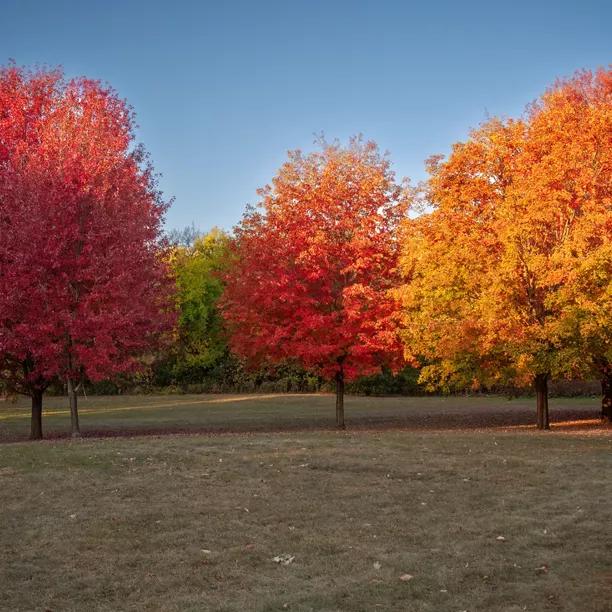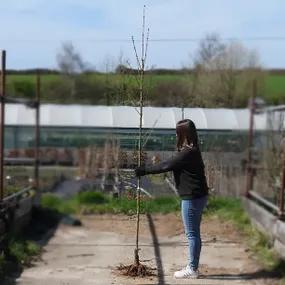Streetwise Maple, Large Trees
Honest Delivery Prices- Native. Likes chalk.
- Upright, tidy tree.
- Max. Height: 7m
- Bareroot Delivery: Nov-Mar.
Recommended extras
Description
Acer campestre Streetwise: Bareroot Maple Trees in Standard Sizes
Streetwise is a field maple with a neat, narrow, upright, egg shaped canopy, which makes it perfect for planting on roadsides, small gardens and other places where space is limited. The spring leaves are brilliant green, deepening as the summer goes on, and the autumn colour is a vibrant orangey-yellow, even better than the wild species. The winged seeds have a pink tinge.
It will reach a height of about 7-8 metres with a spread of 3 metres.
Browse our other Maple varieties, or all of our trees.
Delivery season: Maple trees are delivered bareroot during late autumn and winter, approximately November-March inclusive.
Choosing a size: Small trees are cheaper, easier to handle and more forgiving of less than ideal aftercare, so they are best for a big planting project. If instant impact is your priority, or if you are only buying a few plants for use in a place where it is convenient to water them well in their first year, then you may as well use bigger ones. All our bareroot trees are measured by their height in centimetres above the ground (the roots aren't measured).
Features:
- Height: 7-8m
- Soil: Any well drained
- Neat upright habit, ideal for roadsides
- Bareroot delivery only: November-March
Growing Maples
This hardy tree will grow almost anywhere, except on very acidic or really dry soil. Suitable for exposed locations except on the coast. It thrives on chalk and does not mind winter waterlogging.
It tolerates urban pollution well, and dappled shade cast by taller trees.
Avoid pruning in late winter / early Spring, because it will bleed sap.
Planting Instructions
Notes on planting Acer campestre Streetwise trees:
Acer campestre will grow in pretty much any soil apart from very acidic, peaty earth. It likes thrives on chalk and limestone. It tolerates sites with poor drainage, although it won't grow in a swamp. It will grow well in partial shade or a full day of dappled shade cast by a larger tree growing over it.
Field Maple is fine to grow in the inner city. It is suitable for exposed and very cold sites, but it won't grow on the coast.
Prepare your site before planting:
It is good to dig over the site where you plant a tree several months in advance. Kill the weeds first: for tough weeds like nettles, brambles and ground elder, you will usually need a weed-killer to get rid of them. When you dig the soil over, remove stones and other rubbish and mix in well rotted compost or manure down to the depth of about 2 spades.
Watch our video on how to plant a tree for full instructions.
Remember to water establishing trees during dry weather for at least a year after planting.
Tree Planting accessories:
Prepare your site for planting by killing the weeds and grass.
You can buy a tree planting pack with a wooden stake & rubber tie to support the tree and a mulch mat with pegs to protect the soil around the base of your tree from weeds and drying out.
We suggest that you use mycorrhizal "friendly fungi" on the roots of all newly planted large trees: if your soil quality is poor, we strongly recommend it.
You can also improve your soil with bonemeal organic fertiliser.
After you plant a tree, the most important thing to do is water it in dry weather. You will also need to weed around the plants. Watering should be thorough, so the ground is soaked. Let the soil almost dry out before watering again. Watering & weeding will be necessary for at least a year after planting.
If your trees do need pruning, it is best to do this in mid-summer, unlike most deciduous trees. Acer species will bleed sap quite heavily if they are pruned at other times of the year, which makes it harder for them to heal. Always hire a tree surgeon to remove large branches.
Special notes on caring for Acer campestre Streetwise trees:
Acer campestre Streetwise is a very tough tree that shouldn't need special attention once it has established.
Remember to check the stake and tie supporting your trees a few times a year. Tighten the tie if it becomes loose and loosen it as the tree grows. Make sure that the tree's trunk isn't rubbing against the stake.
Hygiene & Diseases:
Dead, damaged or diseased wood can be pruned off as soon as it appears.
Disinfect your pruning tools between every cut if there is any sign of disease.
Burn or dispose of any diseased material, do not compost it.
Did You Know?
This tree was bred by Hillier Nursery under the direction of Hossein Arshadi, and released in 1998 after 20 years of fine-tuning. It is a disease resistant alternative to Acer Queen Elizabeth, which is otherwise a very similar tree.
Standard trees are measured by their girth in centimetres 1 metre above ground level: their trunk's waist measurement. Unlike sapling trees and hedge plants, standards aren't measured by their height, which will vary quite a bit both between and within species.
So, a 6/8cm standard tree has a trunk with a circumference of 6-8cm and an 8/10 standard has a trunk 8-10cm around. This measurement makes no difference to the tree's final height.
On average, standard trees are 2-3.5 metres tall when they arrive, but we cannot tell you precisely how tall your trees will be before we deliver them.




